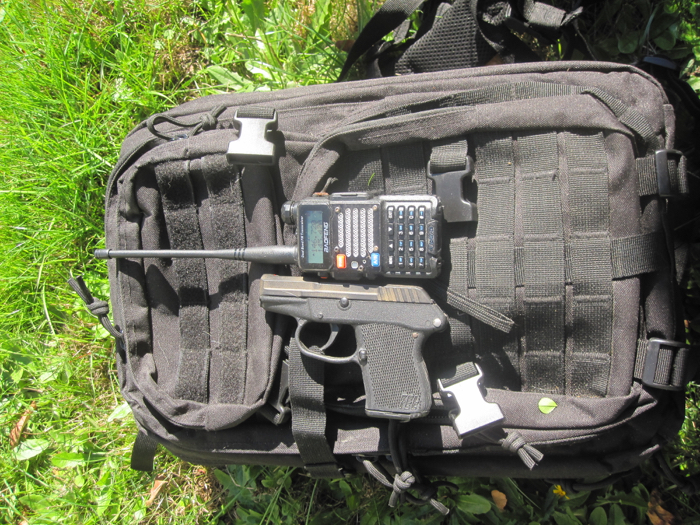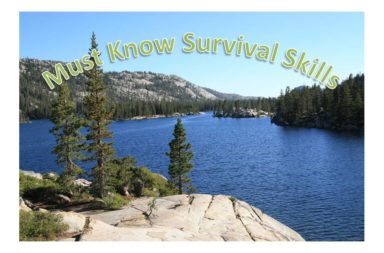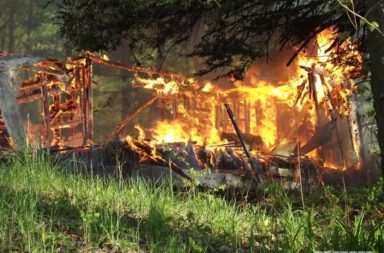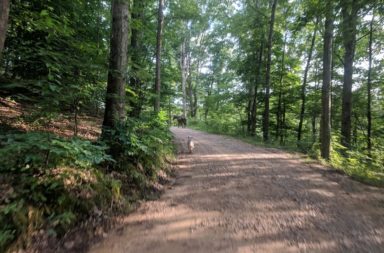Ham radio can be quite rewarding as a hobby and amateur radio skills can be used as a valuable part of your survival plan. As an emergency communications tool, ham radio can be the only thing that lets you communicate with the outside world during a disaster.
What is ham radio, how can you get started, and what is the best way to get setup? Well, let’s start at the beginning, and discover how what started out as a late 19th century technology can still not only benefit you in the 21st century, but be used as an essential prepping skill.
What Is Ham Radio
To many, everything about amateur radio can seem confusing, even the nickname “ham radio.” Some assume it is an acronym of some sort and capitalize the entire word, although the reality is that “ham” is just a reference to hamfisted operators. In the early days of radio, everything was done with Morse code. A professional radio operator had to have a well developed skill at sending code, while amateurs were often, well, hamfisted in their code sending. The nickname stuck, even though Morse telegraphy is more a hobbyist skill than anything else today.
Some preppers take umbrage with the idea of getting licensed to operate an amateur radio station, and simply buy all the equipment they think they need, and simply plan to operate without a license during an emergency- which is allowed by law, but that sort of short sighted thinking cuts you off from one of the most important aspects of ham radio, which is to say the local networks of operators who form the backbone of emergency communications support. Win, lose, or draw, a license is required if you want to operate your station, and it really isn’t that hard to get.
Getting a ham radio license is neither time consuming or expensive. Free online practice exams let you take mock tests using questions drawn from the current question pool until you consistently master the material. You can use this resource by itself, or purchase a study guide such as the one put out by the Amateur Radio Relay League, which is sort of like the NRA for ham radio.
Ham Radio License Classes
There are three license classes, and none of them require any understanding of Morse code.
- The Technician class license is the easiest to get, but really limits the bands you can access, although it does open up the wildly popular 2 meter band, which is what most local repeater networks operate on. Armed with an inexpensive handheld radio and a Technician license, you could conceivably have all the ham radio you need in an emergency.
- The General class license, which is what I have, opens up every frequency in the amateur radio bands up to use, with the exception of a few fringe areas mostly of interest to very specialized hobbyists.
- The Extra class opens up all frequencies and modes. In reality, unless you want the prestige or are going hardcore into the hobby.
There is precious little reason to go beyond a General class ham radio license, for for the person who just wants to access local repeater nets, a Technician level class is just fine. Obviously I’m generalizing a lot of detail here, but checking out the linked resources will answer any in depth questions you’ll have.

How To Use A Ham Radio License
Let’s assume you have a ham radio license now. What can you do with it, and how does it help with emergency prepping or communication?
You might think of ham radio as using shortwave or high frequency (HF) bands to call hundreds or thousands of miles away, and this is certainly one aspect of it. But unless you are trapped in the middle of nowhere, you don’t usually need that kind of reach out. Instead, one of the most effective ways of communicating is through repeaters and local nets.
Repeaters are just what they sound like, stations that rebroadcast calls received by them. They are often able to be made self sufficient in an emergency with backup power, and give people with even low power handhelds an incredible reach. A good repeater network can let you talk hundreds or thousands of miles depending on how they are interconnected.
Where I live, it is possible to use linked repeaters to reach across several states, thanks to a clever network of repeaters and internet connections between stations. More easily, I can reach across most of the populated portions of the Puget Sound region just by calling one single repeater.
Now you can see the benefits of just being able to access common 2 meter repeaters, and you can do that with a $30 radio off Amazon, and a Technician class license.
Radio Frequency Repeaters
Local emergency nets will operate on local repeaters, and help coordinate communications and pass traffic outside the affected area. If you are going to rely on those nets, you should look at getting involved with local repeater clubs and emergency networks so that you can contribute and help keep them functional. Your Technician class ham radio license also allows for easy local communication among family, friends or members of a survival group.
With a General or Extra class ham radio license, you gain a new level of communications ability. You are now able to access the best and most useful HF bands, you get some serious reach out and touch somebody ability, and can call hundreds and thousands of miles depending on your setup, antenna and atmospheric conditions.
For isolated or rural preppers, this will give you better peace of mind, and an ability to quickly reconnect with the outside world when you need it. You’ll find too, that there are local and regional emergency communications nets that will activate during a disaster on an established frequency, so you have the assurance that during an emergency you aren’t just calling into the aether. The county or regional Emergency Management Agency (EMA) would be a great place to start when seeking a club to join to become a part of a local volunteer ham radio network.
Did you know that there are dedicated organizations that active during an emergency to provide emergency communications? The Amateur Radio Emergency Service (ARES) works with government and non government disaster relief agencies to provide a communications backbone when conventional services are inoperable. At times, ARES is the only reliable means of communications during a disaster, and is the primary tool for coordinating aid and passing messages from survivors.
There are several layers of networked communications ability during a disaster available to a ham radio operator, as well as the ability to operate individually.
Ham Radio Gear
- Backup power supplies are the first thing to consider. Batteries, a generator, solar or wind, or maybe even hand crank chargers can all keep your radio going, although some radios use more power than others. A simple handheld 2 meter radio is a lot easier to keep on the air than say a 1500 watt HF base station!
- For a bare minimum, one of the inexpensive Baofeng radios and an upgraded antenna is all you really need. That’s what goes into my bag when I travel during bad weather, along with a spare charged battery. Don’t get taken in by the zillion different versions- they all have the same basic firmware, and you don’t need the higher 8 watt power, unless you like draining your battery faster.
- A better antenna does more than raw power output. Get a basic 5 watt unit, an upgraded antenna, and an extended battery or two. Good to go! Antennas can be tricky point to consider for ham radio operators. Every operator has their pet antenna, and untold numbers of books and articles have been written about them. The truth is, unless you are doing serious long distance work, any quality commercial antenna for the band or bands you want to operate on will do the job. Just install and tune to the manufacturer and radio instructions and you’ll be fine. It isn’t as sexy as making your own, but it’s quicker and easier.
- You can upgrade from there with a premium brand radio like a Yaesu, or get a portable radio for your car, or a 2 meter base station for your house or cabin. Regardless of your license class, you probably should have a 2 meter handheld and a base station or mobile unit in your car.
- If your license class allows it, a multiband HF station is the way to go. Commonly covering the 10 (sometimes 6) meter to 440 meter bands, these powerful (and expensive!) radios will serve as the heart of your emergency communications needs. Combine with a good antenna, and maybe an amplifier, and you can literally call around the world.
Ham Radio Equipment Costs
Using online resources, you can study for a test for free. Taking the test is free, or a nominal cost to cover examiner expenses.
The radio gear is where the expense comes in. You can start for about $30 using inexpensive imported radios, or drop tens of thousands of dollars on radios, antennas, generators, tuners, and all sorts of fancy goodies.
One thing any prepper should be practicing is keeping things simple. Unless you want to be a hardcore ham radio hobbyist, you just don’t need all the whiz bang gear.
Consider your needs, abilities and finances. After looking into local emergency nets and repeater systems, are you content with a simple 2 meter rig? Will that ensure that you can readily access local emergency communications? Then that’s all you really need.
Do you want or think you might need more ability? Go ahead and get a General class license and a decent 10 meter rig, or an affordable multiband system. For about the price of a decent AR style rifle, you can have a pretty solid station going that will cover a lot of ground.
Do you need a fancy antenna tower? Probably not, unless you have terrain impediments or are in the middle of nowhere (which is where preppers tend to live…or wish they did) or really want to play with the limits of your radio setup.
Remember too, your emergency power backup will depend on what kind of radio setup you are running. The more complex and power hungry, the more expensive your backup power system will be.
If you operate anything more complex than a handheld unit, you’ll want some basic tools, like a soldering iron, and tools to work with coax cable- and the practice to use them when you might have to go out and rebuild a storm damaged antenna.
Ham Radio High Tech Options
Did you know you can interface the internet and ham radio? Software like Echolink can run on your phone or computer, and allow you to call any internet connected station or repeater in the world. If you can connect to any sort of internet, this gives you another tool for communicating, although if you have internet, you probably have other communications tools at your disposal.
It is important to remember that all amateur radio communication is broadcast in the clear, without encryption. In fact it is illegal to obfuscate or use any sort of cryptic communications, so if you don’t want anyone hearing what you have to say, don’t say it over the radio.
The last important part of using a ham radio in your prepping is to know the local community. The amateur radio community is extensive and diverse in membership and interests, so you probably won’t have much trouble finding people compatible with your interests and goals. If nothing else, staying somewhat active is a good way to remain in practice and be better able to quickly integrate into local communications in an emergency. Joining a club is a good way to keep your favorite repeaters functioning and active too.
In short, there is a lot more that could be written, but is beyond the scope of this article. Amateur radio can be incredibly easy and inexpensive to get into and it is a proven emergency communication tool that has been called upon for the worst disasters our nation has faced, from 9-11 to hurricanes.
Ham radio puts you in control of your communications and lets you operate a radio station anywhere you can power it and send a signal, and it should be an important part of your prepper or survival lifestyle and planning.


